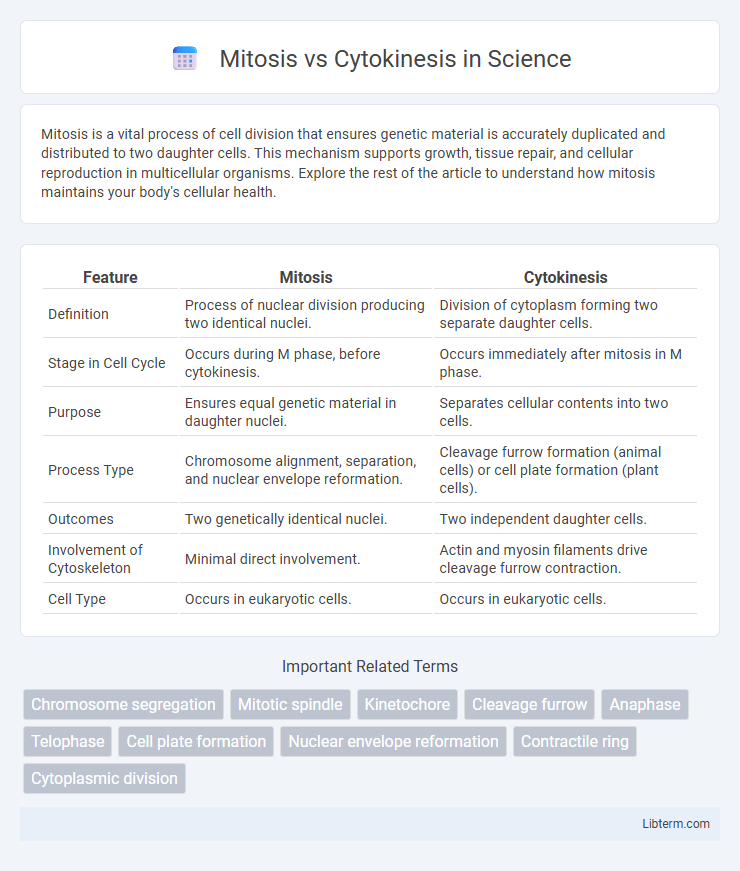Mitosis is a vital process of cell division that ensures genetic material is accurately duplicated and distributed to two daughter cells. This mechanism supports growth, tissue repair, and cellular reproduction in multicellular organisms. Explore the rest of the article to understand how mitosis maintains your body's cellular health.
Table of Comparison
| Feature | Mitosis | Cytokinesis |
|---|---|---|
| Definition | Process of nuclear division producing two identical nuclei. | Division of cytoplasm forming two separate daughter cells. |
| Stage in Cell Cycle | Occurs during M phase, before cytokinesis. | Occurs immediately after mitosis in M phase. |
| Purpose | Ensures equal genetic material in daughter nuclei. | Separates cellular contents into two cells. |
| Process Type | Chromosome alignment, separation, and nuclear envelope reformation. | Cleavage furrow formation (animal cells) or cell plate formation (plant cells). |
| Outcomes | Two genetically identical nuclei. | Two independent daughter cells. |
| Involvement of Cytoskeleton | Minimal direct involvement. | Actin and myosin filaments drive cleavage furrow contraction. |
| Cell Type | Occurs in eukaryotic cells. | Occurs in eukaryotic cells. |
Introduction to Cell Division
Mitosis is the process where a eukaryotic cell's nucleus divides, distributing replicated chromosomes into two daughter nuclei, ensuring genetic consistency. Cytokinesis follows mitosis by physically separating the cytoplasm, creating two distinct daughter cells. Together, these stages complete cell division, essential for growth, development, and tissue repair in multicellular organisms.
Overview of Mitosis
Mitosis is a critical process of eukaryotic cell division that ensures the equal distribution of duplicated chromosomes into two genetically identical daughter nuclei. It consists of distinct phases: prophase, metaphase, anaphase, and telophase, each orchestrating chromosome alignment, separation, and nuclear envelope reformation. This tightly regulated mechanism maintains genetic stability during growth, development, and tissue repair.
What is Cytokinesis?
Cytokinesis is the process that divides the cytoplasm of a parent cell into two daughter cells following mitosis. It ensures that each daughter cell receives an equal amount of cytoplasm and organelles, completing cell division. Unlike mitosis, which separates duplicated chromosomes, cytokinesis physically splits the cell, often through the formation of a cleavage furrow in animal cells or a cell plate in plant cells.
Key Differences Between Mitosis and Cytokinesis
Mitosis is the process of nuclear division that results in two genetically identical daughter nuclei, involving phases such as prophase, metaphase, anaphase, and telophase. Cytokinesis is the subsequent division of the cytoplasm, separating the cell into two distinct daughter cells. Key differences include mitosis managing DNA replication and chromosomal organization, while cytokinesis handles the physical separation of the cell's cytoplasmic content.
The Phases of Mitosis Explained
Mitosis consists of four distinct phases: prophase, metaphase, anaphase, and telophase. During prophase, chromatin condenses into visible chromosomes, and the mitotic spindle forms; metaphase aligns chromosomes at the cell equator. Anaphase separates sister chromatids to opposite poles, while telophase re-establishes the nuclear envelope, completing chromosome segregation before cytokinesis divides the cytoplasm.
Stages of Cytokinesis
Cytokinesis is the final stage of the cell cycle where the cytoplasm divides, resulting in two distinct daughter cells. It begins with the formation of a cleavage furrow, driven by a contractile ring composed of actin and myosin filaments, which progressively deepens to separate the cells. This stage ensures proper distribution of organelles and cellular components, completing the physical division initiated by mitosis.
Importance of Accurate Division
Accurate division during mitosis ensures each daughter cell receives an identical set of chromosomes, maintaining genetic stability essential for organism growth and tissue repair. Cytokinesis complements this process by physically separating the cytoplasm, creating two distinct cells that can function independently. Errors in either phase can lead to aneuploidy or cell malfunction, highlighting their critical roles in healthy cell proliferation.
Common Errors in Mitosis and Cytokinesis
Common errors in mitosis include nondisjunction, where chromosomes fail to separate properly, leading to aneuploidy, and spindle fiber defects that disrupt chromosome alignment and segregation. Cytokinesis errors often involve incomplete cleavage furrow formation or failure of the contractile ring to constrict, resulting in binucleated or multinucleated cells. Both mitotic and cytokinetic abnormalities contribute to cellular dysfunction and are implicated in cancer development and developmental disorders.
Biological Significance in Growth and Repair
Mitosis ensures the accurate replication and distribution of a cell's genetic material to daughter cells, maintaining genetic stability crucial for organismal growth and tissue repair. Cytokinesis completes cell division by physically separating the cytoplasm, producing two distinct cells capable of independent function. Together, these processes facilitate continuous cellular renewal, healing damaged tissues, and supporting developmental growth in multicellular organisms.
Summary: Mitosis vs Cytokinesis
Mitosis is the process of nuclear division that ensures equal distribution of chromosomes into two daughter nuclei, maintaining genetic consistency. Cytokinesis follows mitosis, dividing the cytoplasm and cell membrane to create two separate daughter cells. Together, mitosis and cytokinesis complete cell division, enabling growth and tissue repair.
Mitosis Infographic

 libterm.com
libterm.com